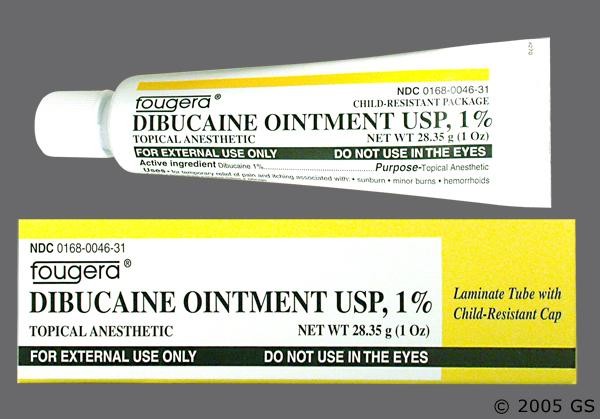
Contents
- 1 dibucaine topical ointment
- 1.0.1 Warnings
- 1.0.2 Side effects of dibucaine topical ointment
- 1.0.3 Dosages of dibucaine topical ointment
- 1.0.4 Drug interactions with dibucaine topical ointment
- 1.0.5 Pregnancy and breastfeeding
- 1.0.6 Additional information about dibucaine topical ointment
- 1.0.7 Subscribe to MedicineNet’s Skin Care & Conditions Newsletter
- 1.0.8 Summary
dibucaine topical ointment
Dibucaine topical ointment is a local anesthetic used for temporary relief of pain and itching caused by sunburn, cuts, abrasions, insect bites, skin irritation, hemorrhoids, and other anorectal disorders. Dibucaine numbs the region by preventing pain signals from reaching the brain. It is available over the counter (OTC) in the U.S.
Dibucaine binds to and blocks sodium channels in neurons, inhibiting the influx of sodium ions and preventing pain signals from being transmitted to the brain.
Warnings
- Do not use dibucaine topical ointment if you are hypersensitive to any component or other amide anesthetics.
- Do not apply dibucaine topical ointment on children below 2 years of age.
- Methemoglobinemia, associated with local anesthetics, has been reported. Monitor at-risk patients closely.
Side effects of dibucaine topical ointment
Common side effects include skin irritation, burning, photosensitivity, contact dermatitis, angioedema, flushing, eye irritation, chest pain, palpitations, diarrhea, nausea, and vomiting.
Call your doctor immediately if you experience any of the following symptoms or serious side effects:
- Fast or pounding heartbeats, fluttering in your chest, shortness of breath, sudden dizziness
- Severe headache, confusion, slurred speech, severe weakness, vomiting, loss of coordination, feeling unsteady
- Nervous system reaction with very stiff muscles, high fever, sweating, confusion, fast or uneven heartbeats, tremors, feeling like you might pass out
- Blurred vision, tunnel vision, eye pain or swelling, seeing halos around lights
This is not a complete list of side effects. Contact your doctor or report side effects to the FDA at 1-800-FDA-1088.
IMAGES
Dosages of dibucaine topical ointment
Ointment
Adult and Pediatric:
Topical Pain
- Indicated for temporary relief of pain and itching caused by sunburn, cuts, abrasions, insect bites, skin irritation, hemorrhoids, and other anorectal disorders
Children below 2 years (or below 15 kg)
- Safety and efficacy not established
Children above 2 years (and above 15 kg)
- Apply topically to affected area up to 3-4 times/day; do not exceed 7.5 g/day
- Apply topically to affected area up to 3-4 times/day; do not exceed 30 g/day
- Prolonged use not recommended
Administration
- Wash hands before and after administration
- May cover with light dressing if necessary
- Do not apply to open wounds, burns, broken or inflamed skin; do not apply in nose, mouth or eyes
- Pediatric patients should be monitored closely after administration to prevent contact with eyes or mouth
Overdose
- Topical application of dibucaine ointment is unlikely to result in overdose. If orally ingested, it can be highly toxic. Overdose treatment includes gastric lavage, respiratory assistance, and cardiac life support measures, if required.
Drug interactions with dibucaine topical ointment
Inform your doctor of all medications you are currently taking to check for possible interactions. Do not change medication without your doctor’s recommendation.
- No known severe or serious interactions.
- Moderate interactions include methemoglobinemia associated agents.
The above are not all of the possible interactions or adverse effects. For more information, consult the RxList Drug Interaction Checker. Remember to inform your doctor or health care provider of all medications you use.
Pregnancy and breastfeeding
- Use during pregnancy should be cautious and done only if clearly needed.
- It is unknown if the topical application of dibucaine is present in breastmilk.
- Consult your healthcare provider before using any OTC drugs, including dibucaine topical ointment, during pregnancy or while breastfeeding.
Additional information about dibucaine topical ointment
- Use as prescribed or per label instructions.
- Do not exceed recommended dose without physician recommendation.
- Avoid applying on large areas of skin or for prolonged periods.
- Dibucaine topical ointment is for external use only. Avoid contact with eyes, nose, mouth, and inside the rectum.
- Can cause photosensitivity. Avoid direct sunlight.
- Contact your healthcare provider if symptoms do not improve within a week, worsen, or if you experience redness, irritation, swelling, bleeding, or other symptoms.
Subscribe to MedicineNet’s Skin Care & Conditions Newsletter
By clicking "Submit," I agree to the MedicineNet Terms and Conditions and Privacy Policy. I also agree to receive emails from MedicineNet and understand that I may opt out of MedicineNet subscriptions at any time.
Summary
Dibucaine topical ointment is a local anesthetic used for temporary relief of pain and itching caused by various conditions. Common side effects include skin irritation, burning, photosensitivity, contact dermatitis, angioedema, flushing, eye irritation, chest pain, palpitations, diarrhea, nausea, and vomiting. Consult your doctor if pregnant or breastfeeding.
Dibucaine topical ointment is a local anesthetic used for temporary relief of pain and itching caused by various conditions. Common side effects include skin irritation, burning, photosensitivity, contact dermatitis, angioedema, flushing, eye irritation, chest pain, palpitations, diarrhea, nausea, and vomiting. Consult your doctor if pregnant or breastfeeding.


